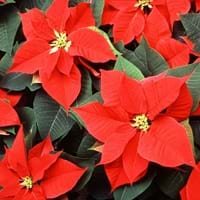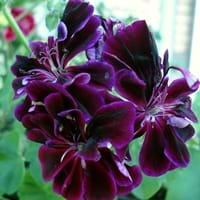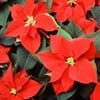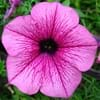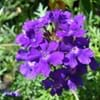Life Span
Perennial
Annual
Type
Shrub
Tender Perennial
Origin
Mexico
Hybrid origin
Types
Prestige Red Poinsettiea, Snowcap White Poinsettia, Sparkling Punch Poinsettia, Enduring Pink Poinsttia
Not Available
Habitat
Forest edges, Tropical regions
All sorts of environments
USDA Hardiness Zone
9-15
10-15
AHS Heat Zone
12-10
Not Available
Sunset Zone
H1, H2, 13, 16, 17, 18, 19, 20, 21, 22, 23, 24
8, 9, 12, 13, 14, 15, 16, 17, 18, 19, 20, 21, 22, 23, 24
Habit
Upright/Erect
Clump-Forming
Flower Color
Yellow, Red, Light Pink, Coral
Hot Pink, Coral
Flower Color Modifier
Multi-Color
Bicolor
Fruit Color
Not Available
Not Available
Leaf Color in Spring
Green, Dark Green
Green
Leaf Color in Summer
Dark Green
Green
Leaf Color in Fall
Dark Green
Green
Leaf Color in Winter
Green, Dark Green
Light Green
Leaf Shape
Bracts
Acicular
Plant Season
Fall, Winter
Spring, Summer, Fall, Winter
Sunlight
Full Sun, Partial Sun
Full Sun, Partial Sun
Type of Soil
Loam, Sand
Loam, Sand
The pH of Soil
Acidic, Neutral
Neutral
Soil Drainage
Well drained
Well drained
Bloom Time
Late Fall, Early Winter, Winter
Indeterminate
Tolerances
Drought
Drought
Where to Plant?
Container, Ground, Pot
Ground, Pot
How to Plant?
Seedlings
Leaf Cutting, Root Division, Seedlings, Stem Cutting
Plant Maintenance
Medium
Medium
Watering Requirements
Keep the ground moist but not water-logged, Requires regular watering, Requires watering in the growing season
Do not water excessively
In Summer
Lots of watering
Moderate
In Spring
Moderate
Moderate
In Winter
Average Water
Average Water
Soil pH
Acidic, Neutral
Neutral
Soil Type
Loam, Sand
Loam, Sand
Soil Drainage Capacity
Well drained
Well drained
Sun Exposure
Full Sun, Partial Sun
Full Sun, Partial Sun
Pruning
Do not prune during shooting season, Prune after flowering, Prune lower leaves, Prune to control growth, Requires little pruning
Prune regularly, Remove damaged leaves, Remove dead branches, Remove dead leaves
Fertilizers
All-Purpose Liquid Fertilizer
All-Purpose Liquid Fertilizer, fertilize every 2-3 weeks while growing
Pests and Diseases
Bacterial Stem Rot, Botrytis Blight, Canker, Powdery mildew, Pythium rot, Rhizoctonia Root Rot
Red blotch, Whiteflies
Plant Tolerance
Drought
Heat And Humidity
Flower Petal Number
Single
Semi-Double
Fragrant Bark/Stem
No
Yes
Foliage Texture
Coarse
Medium
Foliage Sheen
Matte
Matte
Attracts
Not Available
Not Available
Allergy
Eye irritation, Mouth itching, Skin rash, Stomach burn, Throat itching
Not Available
Aesthetic Uses
Beautification, Bouquets, Showy Purposes
Showy Purposes
Beauty Benefits
Not Available
Moisturizing, Skin cleanser
Environmental Uses
Air purification
Air purification, Insect Repellent
Medicinal Uses
Fever, Pain killer, Tooth ache
Fever, Intestinal irritations, Kidney problems, Respiratory Disorders, Wounds
Part of Plant Used
Flowers, Leaves
Flowers
Other Uses
Economic Purpose, Showy Purposes, Used as Ornamental plant
Cosmetics, Culinary use, Making Perfumes, Oil is used for aromatherapy, Showy Purposes, Used as a nutritious food item
Used As Indoor Plant
Yes
Yes
Used As Outdoor Plant
Yes
Yes
Garden Design
Container, Feature Plant, Houseplant, Mixed Border, Tropical
Bedding Plant, Container, Edging, Hanging Basket, Houseplant, Mixed Border
Botanical Name
EUPHORBIA pulcherrima '490 Jingle Bells'
PELARGONIUM 'Balgalpipn'
Common Name
Poinsettia
Hybrid Ivy-leaved Geranium, Zonal Geranium
In Hindi
Poinsettia
Pelargonium
In German
Poinsettia
Pelargonium
In French
Poinsettia
Pelargonium
In Spanish
Poinsettia
Pelargonium
In Greek
Αλεξανδρινό
Pelargonium
In Portuguese
Poinsétia
pelargônio
In Polish
Poinsecja
Pelargonium
In Latin
Poinsettia
Pelargonium
Phylum
Anthophyta
Magnoliophyta
Class
Eudicotyledones
Magnoliopsida
Order
Malpighiales
Geraniales
Family
Euphorbiaceae
Geraniaceae
Genus
Euphorbia
Pelargonium
Clade
Angiosperms, Eudicots, Rosids
Angiosperms, Eudicots, Rosids
Tribe
Not Available
Not Available
Subfamily
Not Available
Not Available
Importance of Poinsettia and Pelargonium
Want to have the most appropriate plant for your garden? You might want to know the importance of Poinsettia and Pelargonium. Basically, these two plants vary in many aspects. Compare Poinsettia and Pelargonium as they differ in many characteristics such as their life, care, benefits, facts, etc. Every gardener must at least have the slightest clue about the plants he wants to plant in his garden. Compare their benefits, which differ in many ways like facts and uses. The medicinal use of Poinsettia is Fever, Pain killer and Tooth ache whereas of Pelargonium is Fever, Intestinal irritations, Kidney problems, Respiratory Disorders and Wounds. Poinsettia has beauty benefits as follows: Not Available while Pelargonium has beauty benefits as follows: Not Available.
Compare Facts of Poinsettia vs Pelargonium
How to choose the best garden plant for your garden depending upon its facts? Here garden plant comparison will help you to solve this query. Compare the facts of Poinsettia vs Pelargonium and know which one to choose. As garden plants have benefits and other uses, allergy is also a major drawback of plants for some people. Allergic reactions of Poinsettia are Eye irritation, Mouth itching, Skin rash, Stomach burn and Throat itching whereas of Pelargonium have Not Available respectively. Having a fruit bearing plant in your garden can be a plus point of your garden. Poinsettia has no showy fruits and Pelargonium has no showy fruits. Also Poinsettia is flowering and Pelargonium is not flowering . You can compare Poinsettia and Pelargonium facts and facts of other plants too.
